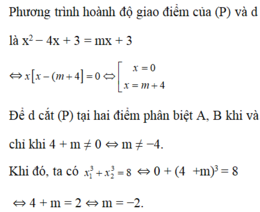Hãy nhập câu hỏi của bạn vào đây, nếu là tài khoản VIP, bạn sẽ được ưu tiên trả lời.

Phương trình hoành độ giao điểm:
`mx-3=x^2`
`<=>x^2-mx+3=0` (1)
(P) cắt (d) tại 2 điểm phân biệt `<=>` PT (1) có 2 nghiệm phân biệt.
`<=> \Delta >0`
`<=>m^2-3>0`
`<=> m<-\sqrt3 \vee m>\sqrt3`
Viet: `{(x_1+x_2=m),(x_1x_2=3):}`
`|x_1-x_2|=2`
`<=>(x_1-x_2)^2=4`
`<=> (x_1+x_2)^2-4x_1x_2=4`
`<=>m^2-4.3=4`
`<=>m= \pm 4` (TM)
Vậy....

Phương trình hoành độ giao điểm:
\(x^2-2x-3=x-m\)
\(\Leftrightarrow x^2-3x+m-3=0\left(1\right)\)
\(\left(d\right)\) cắt \(\left(P\right)\) tại hai điểm phân biệt nằm cùng một phía với trục tung khi phương trình \(\left(1\right)\) có hai nghiệm phân biệt cùng dấu
\(\left\{{}\begin{matrix}\Delta>0\\x_1x_2>0\end{matrix}\right.\Leftrightarrow\left\{{}\begin{matrix}21-4m>0\\m-3>0\end{matrix}\right.\Leftrightarrow3< m< \dfrac{21}{4}\)
Theo định lí Vi-et: \(x_1+x_2=3\Rightarrow x_2=3-x_1\)
\(x^2_2=16x^2_1\)
\(\Leftrightarrow\left(3-x_1\right)^2=16x^2_1\)
\(\Leftrightarrow x_1^2-6x_1+9=16x^2_1\)
\(\Leftrightarrow15x_1^2+6x_1-9=0\)
\(\Leftrightarrow\left[{}\begin{matrix}x_1=-1\\x_1=\dfrac{3}{5}\end{matrix}\right.\)
Nếu \(x_1=-1\Rightarrow m=-1\left(l\right)\)
Nếu \(x_1=\dfrac{3}{5}\Rightarrow m=\dfrac{111}{25}\left(tm\right)\)
Vậy \(m=\dfrac{111}{25}\)

b: Thay x=1 vào (P), ta được:
\(y=1^2+5\cdot1+2=1+5+2=8\)
Thay x=1 và y=8 vào (d), ta được:
\(m\cdot1=8\)
hay m=8

Phương trình hoành độ giao điểm:
\(x^2+2x-m+1=x+1\)
\(\Leftrightarrow x^2+x-m=0\left(1\right)\)
\(\left(d\right),\left(P\right)\) cắt nhau tại hai điểm phân biệt khi phương trình \(\left(1\right)\) có hai nghiệm phân biệt
\(\Leftrightarrow\Delta=4m+1>0\Leftrightarrow m>-\dfrac{1}{4}\)
Phương trình \(\left(1\right)\) có hai nghiệm phân biệt \(x=\dfrac{-1\pm\sqrt{4m+1}}{2}\)
\(x=\dfrac{-1+\sqrt{4m+1}}{2}\Rightarrow y=\dfrac{1+\sqrt{4m+1}}{2}\Rightarrow A\left(\dfrac{-1+\sqrt{4m+1}}{2};\dfrac{1+\sqrt{4m+1}}{2}\right)\)
\(x=\dfrac{-1-\sqrt{4m+1}}{2}\Rightarrow y=\dfrac{1-\sqrt{4m+1}}{2}\Rightarrow B\left(\dfrac{-1-\sqrt{4m+1}}{2};\dfrac{1-\sqrt{4m+1}}{2}\right)\)
\(AB=8\Leftrightarrow\sqrt{8m+2}=8\Leftrightarrow m=\dfrac{31}{4}\left(tm\right)\)
2.
a, \(AB=2\sqrt{5},BC=5\sqrt{10},CA=\sqrt{170}\)
\(AM^2=\dfrac{AB^2+AC^2}{2}-\dfrac{BC^2}{4}=\dfrac{65}{2}\Rightarrow AM=\dfrac{\sqrt{130}}{2}\)
b, \(\left\{{}\begin{matrix}x_D-4-2\left(x_D-2\right)+4\left(x_D+3\right)=0\\y_D-3-2\left(y_D-7\right)+4\left(y_D+8\right)=0\end{matrix}\right.\)
\(\Leftrightarrow\left\{{}\begin{matrix}x_D=-4\\y_D=-\dfrac{14}{3}\end{matrix}\right.\)
\(\Rightarrow D\left(-4;-\dfrac{14}{3}\right)\)
c, \(\left\{{}\begin{matrix}\overrightarrow{AA'}=\left(x_{A'}-4;y_{A'}-3\right)\\\overrightarrow{BC}=\left(-5;-15\right)\\\overrightarrow{BA'}=\left(x_{A'}-2;y_{A'}-7\right)\end{matrix}\right.\)
\(AA'\perp BC\Leftrightarrow\left\{{}\begin{matrix}\overrightarrow{AA'}.\overrightarrow{BC}=0\left(1\right)\\\overrightarrow{BA'}=k\overrightarrow{BC}\left(2\right)\end{matrix}\right.\)
\(\left(1\right)\Leftrightarrow-5\left(x_{A'}-4\right)-15\left(y_{A'}-3\right)=0\Leftrightarrow x_{A'}+3y_{A'}=13\)
\(\left(2\right)\Leftrightarrow\left\{{}\begin{matrix}x_{A'}-2=-5k\\y_{A'}-7=-15k\end{matrix}\right.\Leftrightarrow3x_{A'}-y_{A'}=-1\)
\(\left\{{}\begin{matrix}x_{A'}+3y_{A'}=13\\3x_{A'}-y_{A'}=-1\end{matrix}\right.\)
\(\Leftrightarrow\left\{{}\begin{matrix}x_{A'}=1\\y_{A'}=4\end{matrix}\right.\Rightarrow A'\left(1;4\right)\)

Theo phương trình hoành độ giao điểm:
\(x+1-m=-x^2\)
\(\Leftrightarrow x^2+x+1-m=0\)
Phương trình cần 2 nghiệm phân biệt:
\(\Rightarrow\Delta>0\)
\(\Leftrightarrow1^2-4\left(1-m\right)>0\)
\(\Leftrightarrow4m-3>0\)
\(\Leftrightarrow m>\frac{3}{4}\)
Theo hệ thức Viet :\(\left\{{}\begin{matrix}x_1+x_2=-1\\x_1x_2=1-m\end{matrix}\right.\)
\(y_1=x_1+1-m\)
\(y_2=x_2+1-m\)
\(x_1+1-m-\left(x_2+1-m\right)=x_1^2-x_2^2+1\)
\(\Leftrightarrow x_1-x_2=x^2_1-x^2_2+1\)
Vậy với \(m>\frac{3}{4}\)thõa mản điều kiện ban đầu (?)